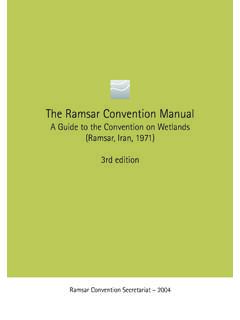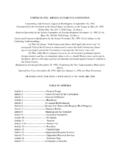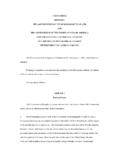Transcription of The Regional Convention for the Conservation of - Persga
1 The Regional Convention for the Conservation of the Red Sea and Gulf of Aden Environment(1982) The Governments of:The Hashemite Kingdom of Jordan, The Kingdom of Saudi Arabia, The Republic of the Sudan, The Democratic Republic of Somalia, Palestine represented by the Palestine Liberation Organization, The Republic of Yemen. Realizing that pollution of the marine environment in the waters of the Red Sea and Gulf of Aden by oil and other harmful or noxious materials arising from human activities on land or at sea, especccially through indiscriminate and uncontrolled discharge of these substances, presents a growing threat to marine life, fisheries, human health.
2 Recreational uses of beaches and other of the special hydrographic and ecological characteristics of the marine environment of the Red Sea and Gulf of Aden and the particular vulnerability of its coral reefs where most biota of the need to ensure that the processes of urban and rural development and resulcctant land use should be carried out in such a manner as to preserve, as far as possible, marine resources and coastal amenities, and that such developments should not lead to deterioration of the marine of the need to ensure that the processes of industrial development should not, in any way, cause damage to the marine environment, jeopardize its living resources or create hazards to human the need to develop an integrated management approach to the use of the marine enviccronment and the coastal areas which will allow the achievement of environmental and developmentcal goals in a harmonious also the need for a carefully planned research.
3 Monitoring and assessment programme in view of the scarcity of scientific information on marine pollution in the that the States of the Red Sea and Gulf of Aden have a special responsibility to protect their marine of the importance of cocoperation and coordination of action on a Regional basis with the aim of protecting the marine environment of the Red Sea and Gulf of Aden for the benefit of all concerned, including future Convention 1982 Bearing in mind the existing international conventions relevant to the present to fulfil the objectives of the Charter of the League of Arab States, and the Charter and Constitution of the Arab League Educational, Cultural and Scientific agreed as follows:Article I: Definitions For the purposes of this Convention and its Protocols, the following terms and expressions have the meanings indicated below, except when otherwise inferred from the text: 1.
4 Conservation of the marine environment of the Red Sea and Gulf of Aden: Rational use by man of living and non-living marine and coastal resources in a manner ensuring optimum benefit for the present generation while maintaining the potential of that environment to satisfy the needs and aspirations of future generations. Such a definition of the term Conservation should be con-cstrued as including Conservation protection, maintenance, sustainable and renewable utilization, and enhancement of the environment. 2. Sea Area : Sea Area as defined in article II of this Convention . 3. Marine pollution : Introduction by man, directly or indirectly, of substances or energy into the marine environment which results or is likely to result in such deleterious effects as harm to living resources, hazards to human health, or hindrance to marine activities including fishing, impairment of quality for use of sea water and reduction of amenities.
5 4. Ships and aircraft : Any waterborne or airborne or amphibious craft of any type whatsoevccer, including hydrofoil boats, air cushion vehicles submersibles, floating craft whether self-propelled or not, and fixed or floating platforms and any other structure. 5. Oil : Petroleum in any form including crude oil, fuel oil, sludge, refined oil, gases and other oil products, whose introduction might impair the marine environment. 6. Harmful substance : Any substance whose introduction or presence in the marine environccment causes a danger threatening or impairing that environment. 7. National Authority : The authority designated by each contracting Party as responsible for the coordination of national efforts for implementing this Convention and its protocols.
6 8. ALECSO : The Arab League Educational Cultural and Scientific Organization. 9. Organization : The Regional Organization for the Conservation of the Red Sea and Gulf of Aden Environment established in accordance with article XVI of this Convention . PERSGA10. Council : The Council established in accordance with article XVI of this Convention . 11. General Secretariat : The organ of the Organization established in accordance with article XVI of this Convention . 12. Action Plan : The Action Plan for the Conservation of the Marine Environment and Coastal Areas of the Red Sea and Gulf of Aden. Article II: Geographical Coverage The present Convention shall apply to the entire sea area, taking into account integrated ecosystems of the Red Sea, Gulf of Aqaba, Gulf of Suez, Suez Canal to its end on the Mediterranean, and the Gulf of Aden as bounded by the following rhumb lines: 1.
7 From Ras Dharbat Ali (lat. 16 39 N, long. 53 E), thence to a point (lat. 16 00 N, long. 53 25 E), thence to a point (lat. 12 40 N, long. 55 00 E) lying of Socotra Island, thence to Ras Hafun (lat. 10 26 N, long. 51 25 E). 2. Any contracting Party may request the Organization to include areas within that Party s national jurisdiction and lying adjacent to those described in paragraph 1 above within the area of application of this Convention or for the purposes of activities resulting therefrom. 3. The geographical coverage does not include internal waters of the contracting parties unless otherccwise stated in this Convention or any of its protocols.
8 Article III: General Obligations 1. The contracting parties shall, individually or jointly, take all appropriate measures, in accordance with the present Convention and those protocols in force to which they are party, for the Conservation of the Red Sea and Gulf of Aden environment including the prevention, abatement and combating of marine pollution. 2. In addition to the Protocol concerning Regional Cocoperation in Combating Pollution by Oil and other Harmful Substances in Cases of Emergency, the contracting parties shall cocoperate in the formulation and adoption of other protocols prescribing agreed measures, procedures and standards for the implementation of this Convention .
9 3. The contracting parties shall establish national standards, laws and regulations as required for the effective discharge of the obligation prescribed in paragraph 1 of this article, and shall endeavour to harmonize their national policies in this regard and for this purpose appoint the National Authority. 4. The contracting parties shall cocoperate with the competent international, Regional and subcregional organizations to establish and adopt Regional standards, recommended practices and procedures for the Conservation of the Red Sea and Gulf of Aden environment, including the prevention, abatement Jeddah Convention 1982and combating of pollution from all sources in conformity with the objectives of the present Convencction, and to assist each other in fulfilling their obligations under the present Convention .
10 5. The contracting parties shall use their best endeavour to ensure that the implementation of the present Convention shall not cause transformation of one type or form of pollution to another which could be more detrimental to the environment. Article IV: Pollution from Ships The contracting parties shall take all appropriate measures in conformity with the present Convention and with generally recognized international rules to prevent, abate and combat pollution in the Sea Area caused by intentional or accidental discharges from ships and shall ensure effective compliance in the Sea Area with generally recognized international rules relating to the control of this type of pollution including loadcon ctop, segregated ballast and crude oil washing procedures for tankers.







